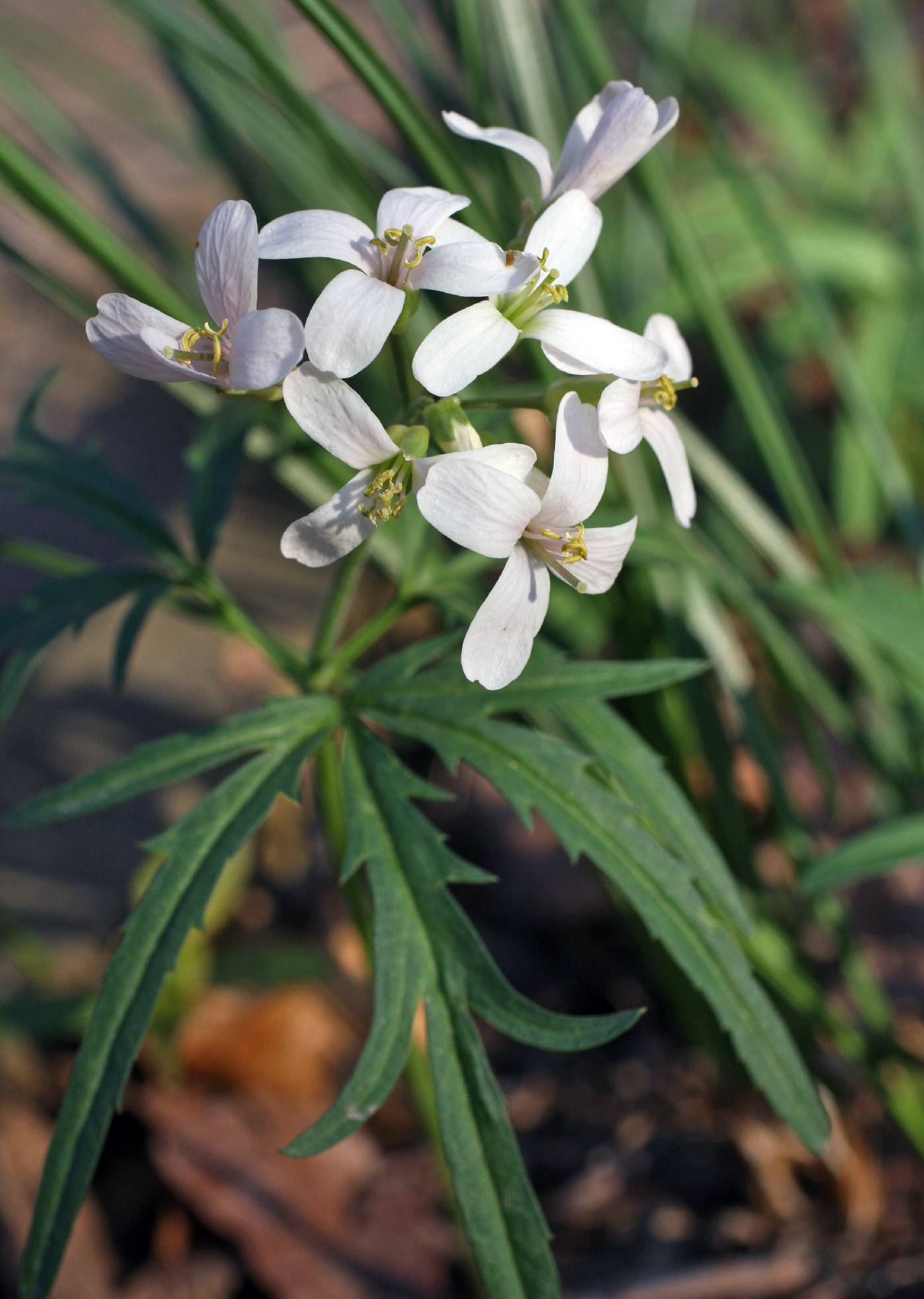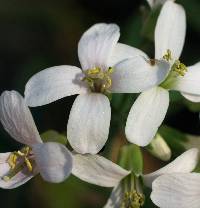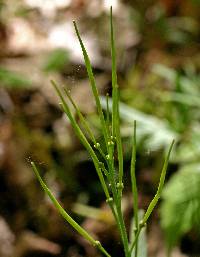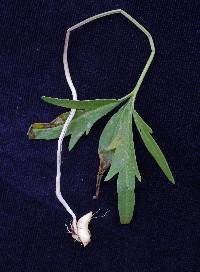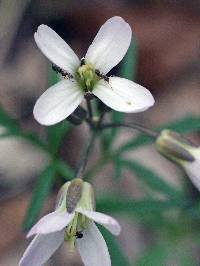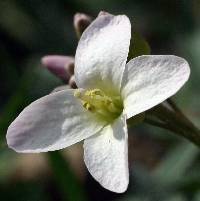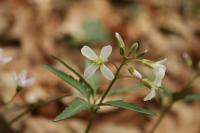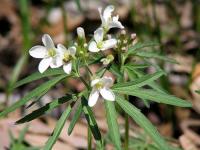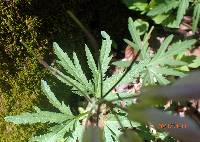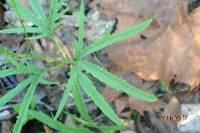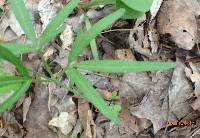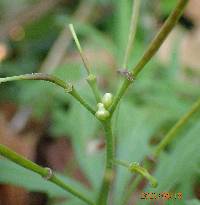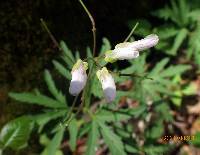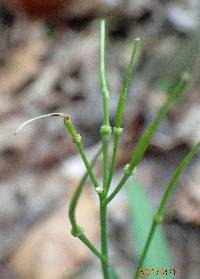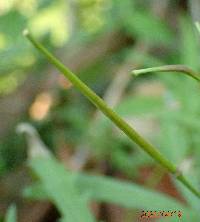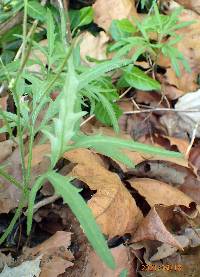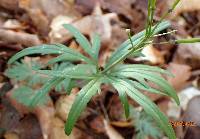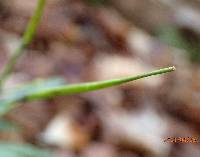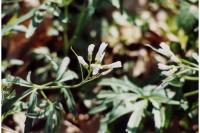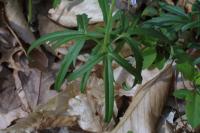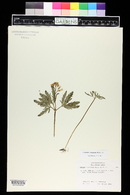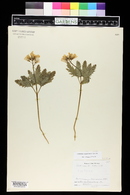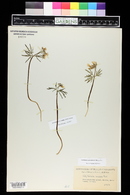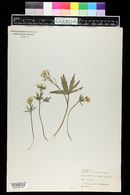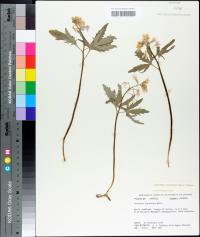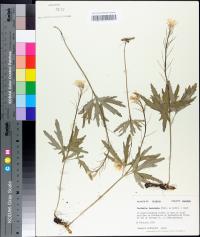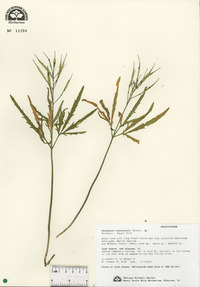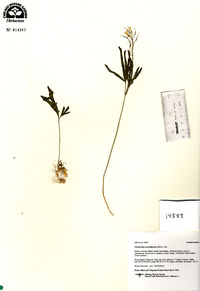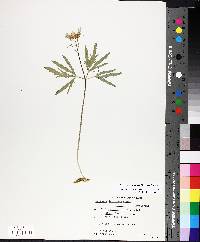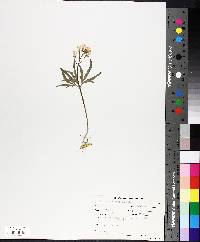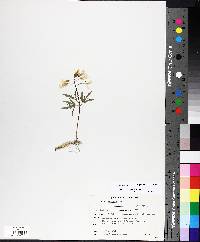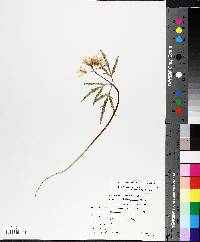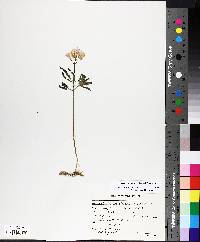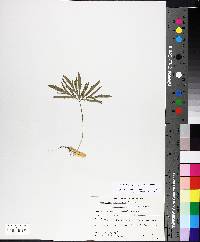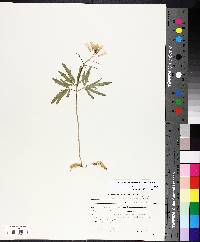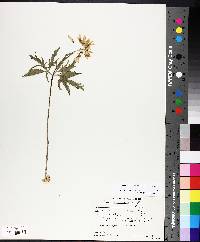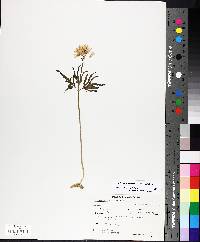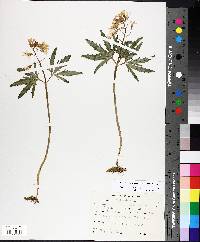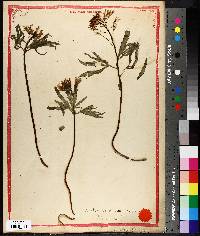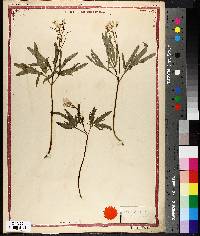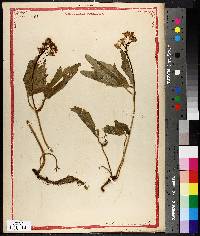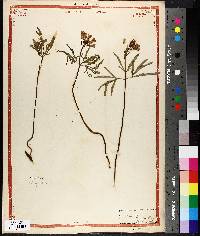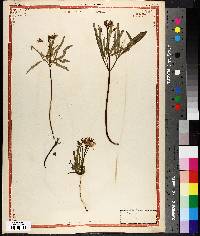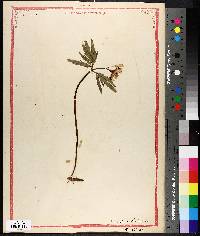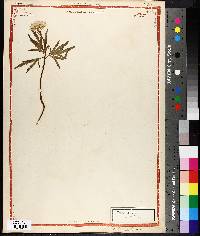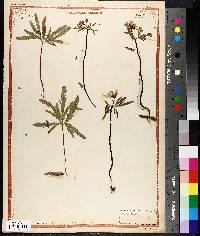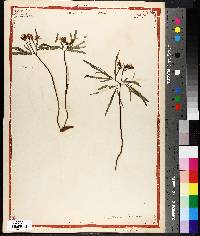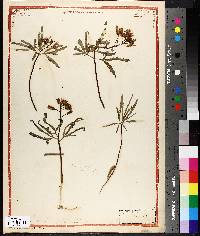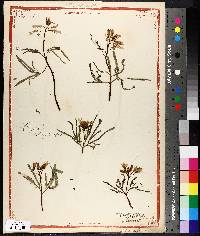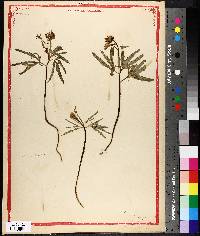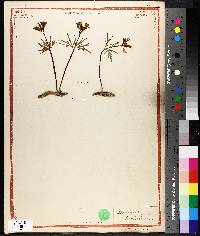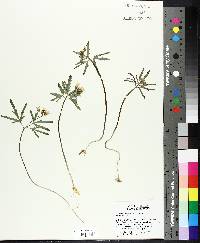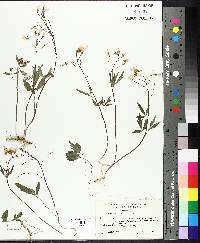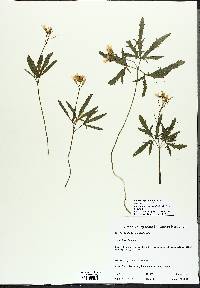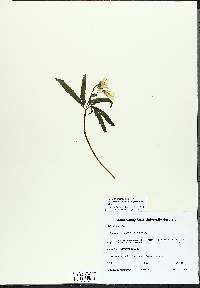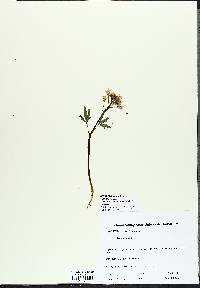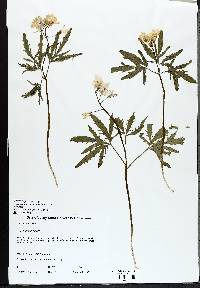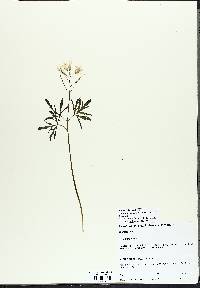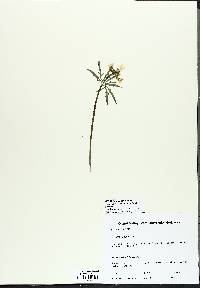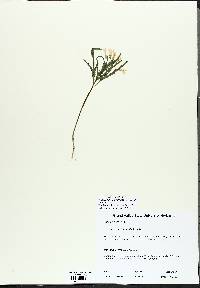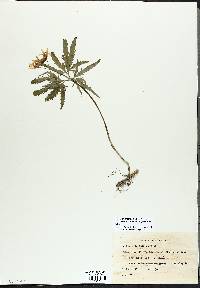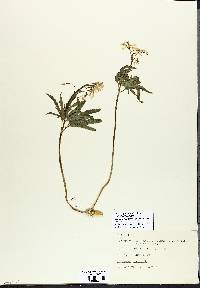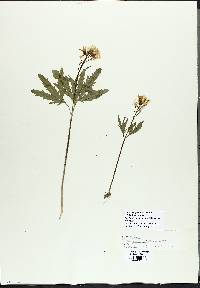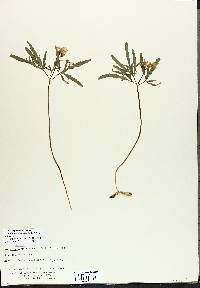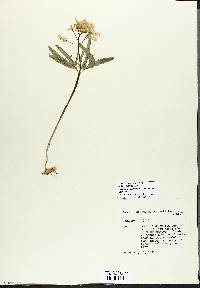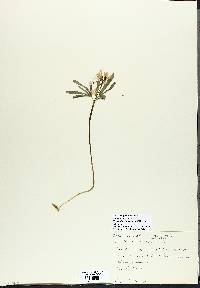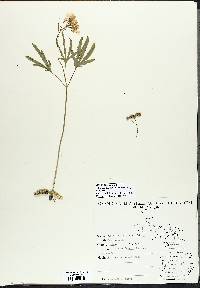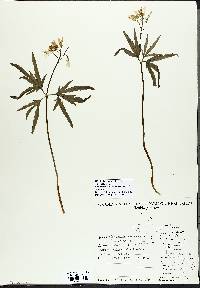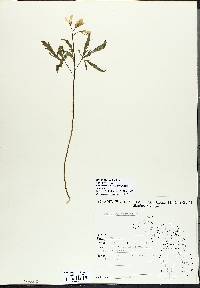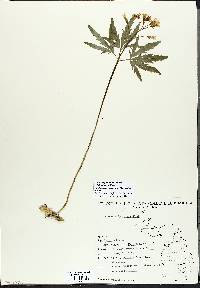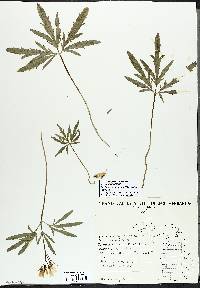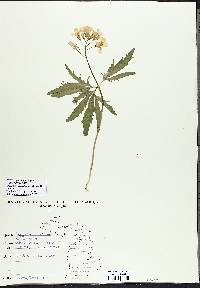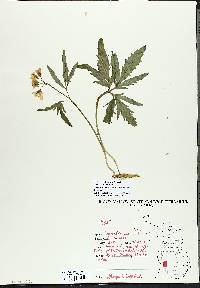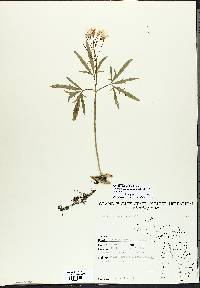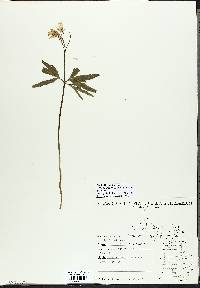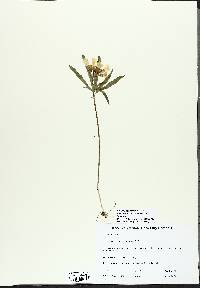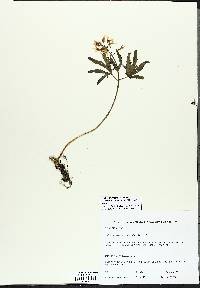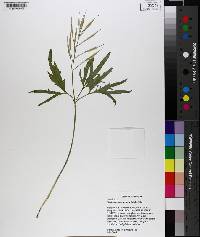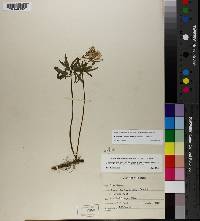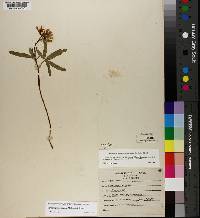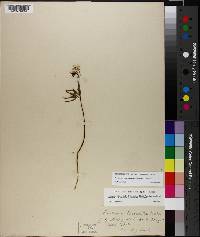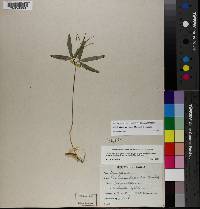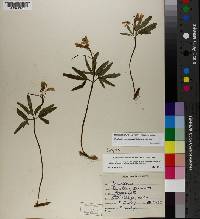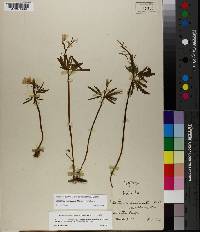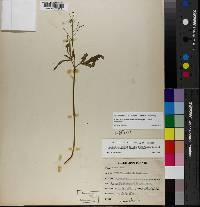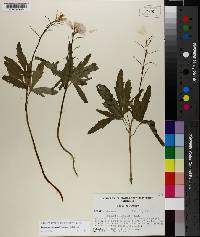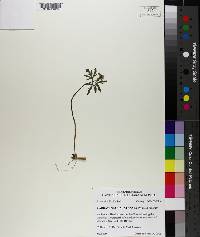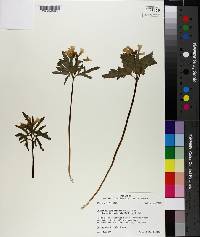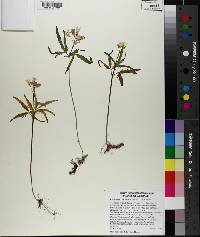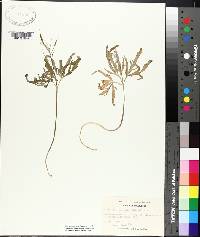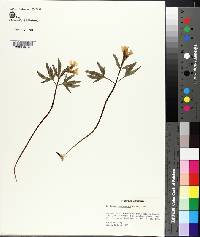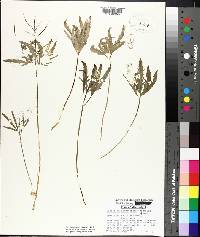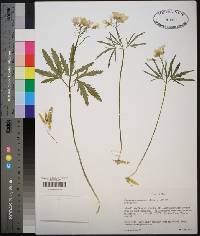Cardamine concatenata
|
|
|
|
Family: Brassicaceae
Cut-Leaf Toothwort, more...cutleaf toothwort
[Cardamine laciniata F.Muell., moreCardamine laciniata var. integra , Dentaria concatenata Michx., Dentaria concatenata var. coalescens , Dentaria laciniata Muhl., Dentaria laciniata var. coalescens Fernald, Dentaria laciniata var. integra Fernald] |
Perennials; usually sparsely pubescent, sometimes glabrous. Rhizomes (tuberiform, fragile), moniliform, segments fusiform, 2-10(-20) mm diam. (fleshy). Stems erect, unbranched, (1-)2-4(-5.5) dm, glabrous or pubescent distally. Rhizomal leaves 3-foliolate, (7-) 10-20(-30) cm, leaflets sessile; petiole (4-)7-18(-25) cm; lateral leaflets similar to terminal, blade sometimes smaller; terminal leaflet blade oblong, lanceolate, oblanceolate, or linear, 2.5-6 cm, base cuneate, margins coarsely dentate to incised, laciniate, or 3-lobed (lobes usually toothed to incised, rarely entire, surfaces puberulent or not, trichomes 0.2-0.3 mm). Cauline leaves (2 or) 3, 3-foliolate (usually whorled or opposite, rarely alternate, similar in morphology to rhizomal leaves), petiolate, leaflets petiolulate or subsessile; petiole (1-)1.5-6(-7.5) cm, base not auriculate; lateral leaflets sessile, blade similar to terminal, sometimes smaller; terminal leaflet subsessile or petiolulate (to 3 cm), blade lanceolate, linear, or oblanceolate, (3-)4-10(-12) cm × (3-)5-20 (-25) mm, margins usually coarsely dentate to incised, rarely subentire (margins minutely puberulent). Racemes ebracteate. Fruiting pedicels ascending to divaricate, (6-) 10-27(-33) mm. Flowers: sepals oblong, (4-)5-8 × 2-4 mm, lateral pair slightly saccate basally; petals white to pale pink, oblanceolate, (8-)10-20 × (3-)4-7(-9) mm, (short-clawed, apex rounded); filaments: median pairs 8-12 mm, lateral pair 6-8 mm; anthers oblong-linear, 1.5-2.5 mm. Fruits linear-lanceolate, (2-)2.5-3.8(-4.8) cm × 1.5-3 mm; (valves glabrous or sparsely pubescent); ovules 10-14 per ovary; style (2-)5-9(-12) mm. Seeds brown, oblong, 1.6-3 × 1.8-2 mm. 2n = 128-256. Flowering Feb-May. Wooded bottoms and bluffs, rich woods, limestone cliffs and outcrops, rocky banks, mesic forests, moist areas with leaf litter, floodplain woods; 0-1000 m; Ont., Que.; Ala., Ark., Conn., Del., D.C., Fla., Ga., Ill., Ind., Iowa, Kans., Ky., La., Maine, Md., Mass., Mich., Minn., Miss., Mo., Nebr., N.H., N.J., N.Y., N.C., Ohio, Okla., Pa., S.C., Tenn., Tex., Vt., Va., W.Va., Wis. Perennial herb 20 - 40 cm tall Stem: upright, shortly hairy in upper parts. Flowers: in a loose, branched cluster, long-stalked, white to pink, 1 - 2 cm long. Sepals four, brownish green, to 3 mm long. Petals four, much longer than sepals. Stamens six. Fruit: a narrow pod, upright, ascending, 2 - 4 cm long, cylindrical. Rhizome: thick, constricted at intervals. The segments are 2 - 3 cm long. Basal leaves: tend to fall off before flowering. Stem leaves: usually three, whorled, above mid-stem, stalked, deeply lobed into three narrowly oblong to lance-shaped segments (lateral segments often divided, giving the appearance of a five-segmented leaf), lobes 6 cm long, 1 cm wide, often sharply toothed. Similar species: The similar Cardamine diphylla differs by having only two nearly opposite leaves and leaf segments that are broadly egg-shaped. Flowering: mid-March to late May Habitat and ecology: Locally abundant in mesic woods. Occurence in the Chicago region: native Notes: The tooth-like projections on the underground stems give this plant its name. Etymology: Cardamine comes from the Greek word kardamon, which refers to plants in the cress family. Concatenate means "linking together." Author: The Morton Arboretum Rhizome constricted at intervals, the segments 2-3 cm; stems 2-4 dm, shortly spreading-hairy above; basal and cauline lvs similar, the former usually absent at anthesis, the latter typically in a whorl of 3 above the middle of the stem, deeply 3-parted or 3-foliolate, the segments linear or lanceolate, subentire to laciniate-toothed, the lateral segments often, the terminal segment sometimes deeply bifid, the whole lf appearing 5-parted; sep 5-8 mm; pet pale lavender, 12-19 mm; frs 2-4 cm; 2n=128, 240, 256. Moist rich woods; Me. and s. Que. to Minn., s. to Fla., La., and Okla. Apr., May, a little earlier than nos. 1 [Cardamine diphylla (Michx.) A. W. Wood] and 5. (Dentaria laciniata) [Cardamine angustata O. E. Schulz] Some possible hybrids with no. 5 have been called Dentaria anomala Eames. Gleason, Henry A. & Cronquist, Arthur J. 1991. Manual of vascular plants of northeastern United States and adjacent Canada. lxxv + 910 pp. ©The New York Botanical Garden. All rights reserved. Used by permission. From Flora of Indiana (1940) by Charles C. Deam Infrequent to frequent in rich woods throughout the state. This species prefers moist soil and deep leaf mold. The variability of the plants has led authors to assign specific, varietal, and hybrid names to these variations. I can do no better than to quote J. M. Coulter (Ann. Rept. Geol. Surv. Indiana 6: 234. 1875) who recognized these variations and said in his flora of Jefferson County: "The leaves vary from almost entire to finely dissected. Sometimes there are three leaves in a whorl; sometimes these leaves are alternate; sometimes there are four alternate leaves; often there are but two leaves either opposite or alternate. In fact there is no kind of division or position of leaves which is not represented in this species." The preceding observation applies to my specimens but I doubt that hybridization is responsible for such variations as the alternate character of the leaves, since, in our area, there are no alternate-leaved species nor entire-leaved species in the genus as now known, with which D. laciniata could hybridize. I believe it is best to regard the genus as a mutating one and some of the aberrant specimens as examples of reversion to ancestral forms. ...... Indiana Coefficient of Conservatism: C = 4 Wetland Indicator Status: FACU |
|
|
|

